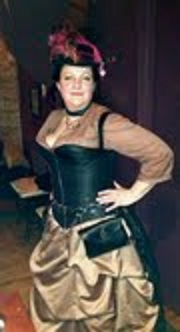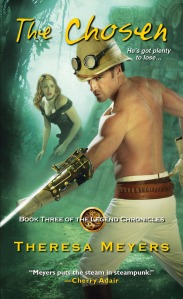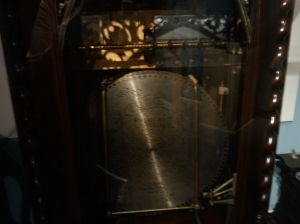Today is the final day of Steampunkapalloza. Thank you so much for helping us celebrate Steamed’s 4th birthday. I can’t believe we’ve been running this for FOUR years–and we couldn’t do it without you.
Today I have a very special post, an interview with James Blaylock, one of the founding fathers of Steampunk. His new steampunk release The Aylesford Skull is available from Titan Books as both a trade paperback and as a special, signed, first edition.
The great folks at Titan have given me a copy of The Aylesford Skull for one of you!!! One lucky person will win! (see below for details.)
Suzanne: Welcome to Steamed! Can you tell us what the story of your recent release is about?
 James Blaylock: That’s a tough question, because the novel is full of plot turns, and I don’t want to give too much away. Even the jacket copy is a spoiler, to some extent. The main character, Professor Langdon St. Ives (featured in other novels, novellas, and stories that I’ve written over the past 35 years) has semi-retired from adventuring and is a gentleman farmer, growing hops in Aylesford, Kent. Loathsome crimes occur in the area, however, and he begins to suspect that his old nemesis, Doctor Narbondo, is up to no good. His new, comfortable life very shortly flies to pieces, and he and a cast of characters become embroiled in personal and world-threatening conflicts involving river pirates, dirigibles, grave robbery, magically altered skulls, kidnappings, swamps, Neolithic coal, paranormal chicanery, and so forth – heaps of things that the reader has been anxiously awaiting without, perhaps, being aware of it.
James Blaylock: That’s a tough question, because the novel is full of plot turns, and I don’t want to give too much away. Even the jacket copy is a spoiler, to some extent. The main character, Professor Langdon St. Ives (featured in other novels, novellas, and stories that I’ve written over the past 35 years) has semi-retired from adventuring and is a gentleman farmer, growing hops in Aylesford, Kent. Loathsome crimes occur in the area, however, and he begins to suspect that his old nemesis, Doctor Narbondo, is up to no good. His new, comfortable life very shortly flies to pieces, and he and a cast of characters become embroiled in personal and world-threatening conflicts involving river pirates, dirigibles, grave robbery, magically altered skulls, kidnappings, swamps, Neolithic coal, paranormal chicanery, and so forth – heaps of things that the reader has been anxiously awaiting without, perhaps, being aware of it.
S: Where did you get the ideas for this story?
JB: I do a lot of research when I’m writing Steampunk, and I find myself abruptly influenced by odds and ends of things that I discover in the moment and that I knew nothing at all about two minutes earlier. I’m also continually influenced by the books that lie around on my desk, and that I read over and over again for the pleasure of it. I’m a fan, for instance, of the novels and stories of Patrick O’Brian and for the short stories of James Norman Hall in the collection titled Dr. Dogbody’s Leg. I tend to reread The Pickwick Papers and whatever volume of Sherlock Holmes stories is closest at hand. All these books are close at hand, in fact, in the “favorite books” bookshelves over the desk. It’s often been the case that I run across throwaway ideas in the things that I read for pleasure: a mention of this or that, or a brief bit of intriguing setting detail. When that happens, sometimes something useful will come into my mind, which I immediately clutch with both hands and hold onto. Also, I’m crazy about old reference books that contain fascinating information that’s long out of fashion, one of my favorites being Wonders of the Universe, a Record of Things Wonderful and Marvelous in Nature, Science and Art (which has a very convincing chapter on plesiosaur sightings). That one piqued my interest in Japanese magic mirrors, which set off a train of strange notions in my mind, resulting in the skull lamps featured in The Aylesford Skull.
S: This is the next in a series, right? How did this series come to be?
JB: That’s a moderately long tale that goes back to 1977, when I wrote a short story titled “The Ape-box Affair” and sold it to Unearth magazine. That was my second sale as a fledgling professional writer, and it became the first Steampunk story published in the U.S. (Actually, K.W. Jeter and Tim Powers and I were all writing that sort of stuff in our own ways, but I lucked into print first.) I was on a Robert Louis Stevenson binge at the time and had recently read The New Arabian Nights and The Dynamiter, and it came into my mind to write a wrong-box story – several similar boxes abroad in London that get mixed up. I was also crazy for P.G. Wodehouse, and my head was full of the sound of his prose and the voices of his goofy characters. I had no idea at the time, but the characters I created in “The Ape-box Affair” would keep surfacing often enough in the following years that very soon they became series characters. They’re more fully drawn now and far more active than they ever were in the past.
S: You’re one of the “founding fathers’ of Steampunk, can you tell us a little about how Steampunk came to be?
JB: K.W. Jeter, Tim Powers, and I were friends (still are) in the 1970s. After we graduated from the university, we were young enough and idle enough to have time to hang around with each other during the day. We were all new writers at the time. I had published my first short story, and Tim and K.W. had sold novels. I was enthusiastically working on an impossible novel, which I would figure out how to write several years later as The Digging Leviathan. All of us were big on Victorian literature. K.W., who had a degree (I seem to remember) in sociology, had read Henry Mayhew’s brilliant London Labour and the London Poor, and was regaling us with wild accounts of treasures and feral pigs in the London sewers and that sort of thing. Tim was researching and writing the novel that would become The Drawing of the Dark, and K.W. was writing Morlock Night. Much of our “research” went on at O’Hara’s Pub in downtown Orange, California, where I lived at the time and still do. (I mean I live in Orange, not at O’Hara’s Pub.) K.W. and Tim were living in a bohemian sort of neighborhood in nearby Santa Ana, where Phil Dick was living at the time. None of us had the idea of writing any particular sort of thing at all. It simply seemed right and natural to set a story where the story seemed to want to be set, and all-things-Victorian were on our minds. It was nearly a decade after “The Ape-Box Affair” and Morlock Night were published that K.W. would coin the term Steampunk, which abruptly gave shape to the whole thing. Up until then we had no idea that these novels and stories formed any sort of science fiction subgenre. We weren’t trying to achieve anything much beyond publishing stories and novels. We might as easily have been writing pirate fantasies (which would come later for me, unsuccessfully, and for Powers, successfully) or vegetarian thrillers or protozoan stories like Twain’s “The Great Dark,” which I was also fond of at the time. We might easily be Piratepunks or Vegetarianpunks or Pondwaterpunks now.
S: How have you seen Steampunk evolve from when you first started writing to now?
JB: It certainly has changed, largely by growth and the odd and interesting business of its having affected pretty much all the arts by now. Whatever literary tastes a reader might have, he or she can find Steampunk examples of that thing in growing abundance. As for my own writing, however, I’m doing the same thing today that I did 35 years ago when I wrote “The Ape-box Affair.” If the writing has evolved, it has evolved in the sense that I’m a better writer now. I bring 35 years worth of stuff to my writing that I couldn’t bring to it back then. My ear for the language is better, I do more adequate research, I work harder to get rid of anachronism, etc.
S: Are you a plotter or a pantster? Can you tell us a little about your writing style/schedule?
JB: I’m an inveterate outliner, actually: I’m very nervous about promising a story or a novel to a publisher without having a fairly clear idea of what it will entail. Over the years I’ve sold most of my books after showing the outlines to editors, and that was the case with The Aylesford Skull, my first novel to be published by Titan Books. I was happy to provide evidence that I actually had a story to tell, and that Titan could safely advance money to me. That being said, I’ve always hidden the outlines away in the drawer once I’ve finished them, and most of what develops in the novel is purely organic. My best ideas come into my mind during the writing, when I’m not actively looking for them. The outline abdicates once the writing starts, because if the outline is on my mind, then fresh ideas have a harder time finding their way in. I wish I had a writing schedule, actually. Currently I teach full time at Chapman University, and I also direct the Creative Writing Conservatory at the Orange County School of the Arts (where Tim Powers teaches poetry and novel writing). So during the school year you can find me frantically driving around town, eating my peanut butter and jelly sandwich lunch while flying from one place to another. I’m up at 5 a.m. and often put in 12-hour days, but there’s no time to write during most of them. So I grab time during vacations and over the summer. When I’m up against it, my weekends disappear into whatever I’m writing, and I take reference books and etc. along on vacations. Like most writers, sitting down to write is a frustratingly wasted effort unless I have a several-hour block of time in a moderately quiet house – enough time to read something relevant for half an hour first to compose my mind. The Aylesford Skull took two years to write.
S: What’s next? Can you share anything with us about any new projects (in any genre)?
JB: I’ve just turned in another Steampunk novel to Subterranean Press – a short novel that’s a companion to my two previous Sub Press productions: The Ebb Tide and The Affair of the Chalk Cliffs. This new one is titled The Adventure of the Ring of Stones. I’d chat about it here, but in many ways it beggars description. I’m also working up a new novel for Titan Books, which (I’m fairly sure) will tie up a loose end in The Aylesford Skull, although the tying up is only a very small fraction of what the novel will be. Also, a few months back I published a young adult novel titled Zeuglodon, the True Adventures of Kathleen Perkins, Cryptozoologist, and I’ve got the plot for a followup adventure in my mind. That book really wants to be written. In short, I’ve got too many writing projects vying for my time.
S: Anything else you want to tell everyone?
JB: Only that readers are my favorite people, and that if they read my books, I hope they enjoy them. Also, and maybe more vitally, I read recently that a meteor is going to take out the earth in another 25 years. It’s hurtling toward us as we speak, giving us the glad eye. So whatever you really want to do, don’t put it off.
–Cheers, Jim Blaylock
http://jamespblaylock.com/
James Paul Blaylock is noted for a distinctive, humorous style, as well as being one of the pioneers of the steampunk genre. Despite his close association with Steampunk, most of his work is contemporary, realistic fantasy set in southern California, typified by books like The Last Coin, The Rainy Season, and Knights of the Cornerstone. When he’s not teaching or writing, Jim spends his time going to the beach, gardening, working on the family home in Orange, California, traveling, and building sets for local community theaters.
To win The Aylesford Skull just leave a comment below. Open internationally. Contest closes May 7, 2013 at 11:59 pm PST.
—
Suzanne Lazear is the author of the Aether Chronicles series. INNOCENT DARKNESS is out not, CHARMED VENGEANCE releases 8-8-13. Vist www.aetherchronicles.com for more info.
Read Full Post »

 Dawn grasps hold of the arm of the settee, bracing for the shaky landing. “Along my travels, some of the vending I did was in Victorian reenactment. I am well versed in the clothing aspect. Steampunk was a natural progression for me. What intrigues me is the inventions, the people who create them and the stories they tell. The community, the ingenuity and historical knowledge of the artists is just delightful.
Dawn grasps hold of the arm of the settee, bracing for the shaky landing. “Along my travels, some of the vending I did was in Victorian reenactment. I am well versed in the clothing aspect. Steampunk was a natural progression for me. What intrigues me is the inventions, the people who create them and the stories they tell. The community, the ingenuity and historical knowledge of the artists is just delightful.




 Imagine what would happen if a comet came to close to earth in the mid 1800’s. Astronomers saw it coming and knew it would lead to the ultimate destruction of everything in its path. Who would the world chose to save? And how would they save them?
Imagine what would happen if a comet came to close to earth in the mid 1800’s. Astronomers saw it coming and knew it would lead to the ultimate destruction of everything in its path. Who would the world chose to save? And how would they save them?


















